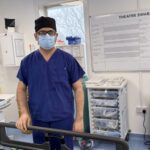
Post-Operative Care | Essential Tips for a Smooth Recovery After Tummy Tuck
Undergoing a tummy tuck (abdominoplasty) is an exciting step towards achieving a firmer, more toned abdomen. Whether it’s to eliminate excess skin after pregnancy or significant weight loss, a tummy tuck can help you regain confidence and feel more comfortable in your body. However, achieving the best results requires diligent post-operative care. Dr. Cheema, a renowned expert in tummy tuck surgeries in Birmingham, emphasizes the importance of proper recovery for a smooth healing process. In this blog, we will walk you through essential tips and guidelines to ensure a quick and smooth recovery after your tummy tuck procedure.
Understanding the Tummy Tuck Procedure:
A tummy tuck, or abdominoplasty, is a cosmetic surgery designed to remove excess skin and fat from the abdominal area. This procedure also tightens the muscles of the abdominal wall, offering a more toned and youthful appearance. The surgery can be performed for a variety of reasons, including post-pregnancy recovery, weight loss, or simply to address the natural aging process.
During the procedure, Dr. Cheema will strategically remove excess skin and fat while reshaping the contours of the abdomen. The surgery can significantly improve the appearance of your abdomen, but proper post-operative care is crucial to achieving the desired outcome.

Immediate Post-Operative Care:
Post-operative care is essential right after your tummy tuck surgery. Immediately after the surgery, you will likely feel groggy and experience some pain and swelling, which is completely normal. Dr. Cheema and his team will provide you with specific instructions to manage your recovery process. Here’s what you can expect:
- Pain Management: Pain after a tummy tuck is common. Dr. Cheema will prescribe pain medications to help manage any discomfort. It’s important to follow the dosage instructions closely for effective pain relief.
- Compression Garment: You will be instructed to wear a compression garment to help reduce swelling and support the healing process. This garment also helps prevent fluid buildup, which can occur after surgery.
- Drains: In some cases, Dr. Cheema may place surgical drains to help remove excess fluid from the area. These drains are typically removed within a few days, depending on your healing progress.
Following Dr. Cheema’s instructions will help minimize the risk of complications and promote faster healing.

Good nutrition is essential during recovery. Your body needs the right nutrients to heal and repair tissue. Here are some tips:
- High-Protein Foods: Protein plays a vital role in healing. Include lean proteins like chicken, fish, and tofu in your diet to help rebuild tissue and muscle.
- Vitamins and Minerals: Vitamins like Vitamin C help in collagen formation, which supports skin healing. Include foods like citrus fruits, leafy greens, and bell peppers in your meals to promote healing.
- Hydration: Drink plenty of water to keep your body hydrated. Staying hydrated helps your body recover more effectively by reducing swelling and supporting the detoxification process.
Avoid processed foods, excess sugar, and alcohol, as these can delay your recovery.
Managing Pain and Swelling:
Swelling and bruising are normal after a tummy tuck. However, you can take steps to minimize discomfort:
- Elevate Your Body: Keeping your upper body elevated will help reduce swelling. This can be done by propping yourself up with pillows when lying down.
- Cold Compress: Applying ice packs to the swollen areas (avoid direct contact with the skin) can reduce swelling and pain. Dr. Cheema’s team will provide guidance on how to apply ice safely.
- Movement: While you should avoid heavy activities, light walking can improve circulation and help reduce swelling. Follow Dr. Cheema’s advice on how much movement is acceptable
Activities to Avoid During Recovery:
The first few weeks after your tummy tuck are crucial for recovery. During this period, it’s important to avoid activities that could strain your body and disrupt the healing process. These include:
- Strenuous Exercise: Avoid heavy lifting, intense cardio, or exercises that strain the abdominal muscles for at least 4-6 weeks.
- Bending and Lifting: Avoid bending over or lifting heavy objects. This could put unnecessary stress on your abdominal muscles, hindering the healing process.
Dr. Cheema will guide you on when it’s safe to resume light activities and when to start gentle exercises to tone and strengthen the abdominal area.
When to Expect Results:
It’s important to have realistic expectations about your tummy tuck recovery. While some initial results may be visible right away, your results will emerge gradually as swelling subsides, and your body continues to heal.
- First Few Weeks: During the first few weeks, you will likely experience swelling and bruising. Your abdomen may appear a bit bloated due to the healing process.
- Months 1-3: As the swelling reduces, the shape of your abdomen will begin to take form. The skin will continue to tighten, and you’ll notice a more sculpted and toned appearance.
- Results: It will take at least 6 months to see the full results of your tummy tuck. Patience is key, but the wait will be worth it for the outcome.
Follow-Up Appointments and Post-Op Checkups:
Follow-up appointments with Dr. Cheema are critical for tracking your recovery. These appointments allow Dr. Cheema to monitor your progress and address any concerns you might have. Here’s what to expect during your post-op checkups:
- Wound Care: Dr. Cheema will check your incisions to ensure proper healing and will give you advice on how to care for your wounds to prevent infection.
- Drain Removal: If drains were used, they will be removed during one of these visits, and any other concerns related to swelling or healing will be addressed.
Potential Complications and How to Prevent Them:
Although tummy tuck surgery is generally safe, complications can arise. Some potential complications include:
- Infection: Infection is a risk after any surgery. To prevent infection, follow Dr. Cheema’s wound care instructions and avoid touching the surgical site with unclean hands.
- Hematoma or Seroma: Blood or tissue fluid buildup beneath the skin can sometimes occur. It’s important to wear your compression garment as instructed to reduce the chances of this happening.
- Blood Clots: While rare, blood clots can occur after surgery. To reduce the risk, follow your doctor’s advice on mobility and stay hydrated.

If you notice any signs of infection (increased redness, warmth, or drainage), contact Dr. Cheema immediately.
Emotional and Psychological Aspects of Tummy Tuck Recovery:
Recovering from surgery isn’t just a physical journey; it’s also an emotional one. It’s normal to feel a mix of emotions after your tummy tuck. Here are a few tips to manage the emotional side of recovery:
- Support System: Surround yourself with supportive friends and family who can encourage you during your recovery. Emotional well-being is just as important as physical healing.
- Patience: The healing process takes time, and it’s essential to be patient with yourself. Focus on the positive changes that are happening in your body.
- Body Image: Tummy tuck surgery is designed to enhance your body and improve self-confidence. Take time to embrace your new look and enjoy the progress you’ve made.
Long-Term Care and Maintenance:
To maintain the results of your tummy tuck, it’s essential to adopt a healthy lifestyle. Here are some tips for long-term care:
- Healthy Diet: Continue eating a balanced diet that supports weight management and skin elasticity.
- Regular Exercise: Once you’re cleared by Dr. Cheema, engage in regular exercise to maintain a healthy weight and keep your body in shape.
- Skin Care: Use moisturizers and sunscreen to keep your skin in good condition and avoid sun exposure, which can damage the skin and affect the results of your surgery.
Smooth Recovery, Stunning Results: Your Tummy Tuck Journey
A tummy tuck is a life-changing procedure, and following the right post-operative care is essential to achieving a smooth and successful recovery. By following Dr. Cheema’s expert guidance on nutrition, pain management, and activity limitations, you can expect to enjoy the results of your surgery sooner and more effectively. Remember, a smooth recovery doesn’t happen overnight, but with patience and care, you’ll soon see the beautiful transformation that a tummy tuck offers. If you’re considering a tummy tuck and want personalized care in Birmingham, contact Dr. Cheema’s office today. Your journey to a more confident you start here.
Frequently Asked Questions (FAQs)
How long does it take to recover after a tummy tuck?
The recovery time after a tummy tuck typically ranges from 6 weeks to several months. During the first 2 weeks, you will need to rest and avoid strenuous activity. After about 6 weeks, most people can resume light activities, but full results months to appear.
What can I expect during the first few days after my tummy tuck?
After your tummy tuck surgery, you may experience swelling, bruising, and discomfort. Dr. Cheema will prescribe pain medication to help manage the discomfort. You will also be instructed to wear a compression garment to help reduce swelling and support the healing process.
What should I avoid doing during the recovery period?
During recovery, it’s important to avoid heavy lifting, vigorous exercise, and any activities that strain your abdominal muscles. You should also refrain from bending, twisting, or stretching your body too much.
How soon can I return to work after a tummy tuck?
Most people can return to work within 1-2 weeks after their tummy tuck, especially if their job doesn’t require heavy physical activity. For more physically demanding work, it may take 4-6 weeks before you’re able to return to your normal routine.
Will I have visible scars after a tummy tuck?
Scarring is a normal part of the tummy tuck procedure, but Dr. Cheema takes great care to make the incisions as discreet as possible, usually along the bikini line. Over time, these scars will fade but may remain visible. Proper care and moisturizing of the area can help minimize scarring.
What should I eat to speed up my recovery after a tummy tuck?
Eating a balanced diet rich in protein, vitamins, and minerals will help speed up your recovery after tummy tuck surgery. Foods like chicken, fish, leafy greens, and fruits high in Vitamin C are excellent for healing. Hydration is also important, so drink plenty of water to keep your body hydrated.
Is tummy tuck surgery painful?
While a tummy tuck is a major surgery, pain is typically manageable with prescribed pain medications. The discomfort you experience will be at its peak during the first few days after surgery but will decrease significantly as you heal.
When will I see the results of my tummy tuck?
While initial results may be visible within a few weeks, it can take 3-6 months to see the final, fully healed results of your tummy tuck surgery. Swelling will continue to subside, and the contour of your abdomen will become more defined as your body heals
How can I maintain my results after a tummy tuck?
To maintain your tummy tuck results, it’s important to adopt a healthy lifestyle with a balanced diet and regular exercise. Avoiding significant weight gain is crucial, as it can affect the results of your surgery.
What are the risks and complications of tummy tuck surgery?
As with any surgery, there are risks associated with tummy tuck procedures, including infection, scarring, blood clots, and poor wound healing. However, these risks are minimized with proper care and following Dr. Cheema’s instructions. It’s essential to attend follow-up appointments to ensure any potential issues are addressed promptly.
Can I have a tummy tuck if I plan to get pregnant in the future?
It is recommended to wait until after you’ve completed your family planning before having a tummy tuck. Pregnancy can affect the results of the surgery by stretching the abdominal muscles and skin again. If you’re considering a tummy tuck and plan to get pregnant, discuss your options with Dr. Cheema to determine the best approach.

Internationally trained Plastic, Reconstructive & Aesthetic Surgeon.







Leave a Reply